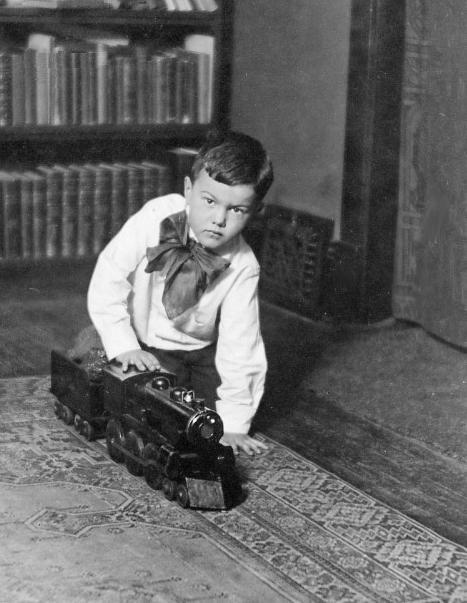
Early American Toy Trains (19th Century)

Figure 1.--This snapshot was probably taken about 1905-10. It shows how American boys played with their toy trains through most of the 19th century. Pull toys were another popular approach. At the time this potograph was taken, electric trains were beginning to appear. You can bet that an electric train set would be high on this boy's wish list when they ppeared.
|
|
Toy trains were very popular in America during the 19th century. When railroads first arrived in the United States, in the 1830s and 1840s, we can be confident that primitive toy models of trains were created. Initally they were mostly simple wooden affairs, typically a representation of a steam locomotive and a few cars, such as a passenger car or a box car. They might be equipped with wheels and could serve as pull toys, to pulled on a string or pushed along the floor by the child. Track for toy trains came later. Meanwhile, the child's imagination could suffice. After all, toys have always been intended to entertain the child, with the general realization that his imagination would fill in for the shortcomings of his toys, including his toy trains when compared with trains in the real world. But, children are generally very imaginative, so that even a 1-year old exhibits degrees of imagination in play, and we can appreciate that play and imagination are aspects of thinking and learning that generally advance rapidly as the child continued to grow. We see boys with toy trains in early photographs. Trains appeared at about the same time as the invention of photography. We do not yet have any photograpohic images of toys trains from the early photography of the 1840s and 50s. With the invention of albumen images and the CDV, the number of images exploded and we begin to see images of toy trains. Some as early as the 1860s were quite realistic looking.
A good example is an unidentified boy in the 1860s. These were not self-propelled toys. Boys had go push or pull them. We do not know much about manufacturers for early toy trains. Presummably some were imported from Britain where the rail road first became a major institution.
First Toy Trains
Toy trains were very popular in America during the 19th century. When railroads first arrived in the United States, in the 1830s and 1840s, we can be confident that primitive toy models of trains were created. Initally they were mostly simple wooden affairs, typically a representation of a steam locomotive and a few cars, such as a passenger car or a box car. They might be equipped with wheels and could serve as pull toys, to pulled on a string or pushed along the floor by the child. Track for toy trains came later.
Imagination
Meanwhile, the child's imagination could suffice. After all, toys have always been intended to entertain the child, with the general realization that his imagination would fill in for the shortcomings of his toys, including his toy trains when compared with trains in the real world. But, children are generally very imaginative, so that even a 1-year old exhibits degrees of imagination in play, and we can appreciate that play and imagination are aspects of thinking and learning that generally advance rapidly as the child continued to grow.
Photography
We see boys with toy trains in early photographs. Trains appeared at about the same time as the invention of photography. We do not yet have any photograpohic images of toys trains from the early photography of the 1840s and 50s. With the invention of albumen images and the CDV, the number of images exploded and we begin to see images of toy trains. Some as early as the 1860s were quite realistic looking.
A good example is an unidentified boy in the 1860s.
Manufacturers
We do not know much about the manufacturers for early toy trains. Presummably some were imported from Britain where the rail road first became a major institution.
Realism
We do not know much about the earliest toy trains. We note some very realistic-looking toy trains by the 1860s. It is a little difficult to tell the naterial used. They may hasve been done in bronze. These would have been very expensive toys. We note cast iron toy trains by the 1880s, aklthough they may have appeared earlier. This allowed a a great degree of realism than the early wooden models and a less expensive toy than the more elaborate bronze models. They were still very short on detail as compared with toy trains that came later.
Play
Most of these cast toys were also push or pull toys. They as well as the earlier wooden and bronze trains were be pulled with a string or pushed on the floor. Importantly, the child could link them with other objects, such as blocks and wooden boxes, to create a village or town, or to create a country scene with tunnels and hills. Imagination was the key, so the degree to which the toy models were realistic may have been more or less incidental. The photographic record suggests that such layouts before tracked trains were developed was fairly limited. Boys, and no doubt their sisters as well, enjoyed playing with them. Pushing and pulling continued to be the way noys played with the toys into the early-20th century. This had the affect of limiting the age range at which boys were interested in toy trains.
HBC

Navigate the Boys' Historical Clothing Web Site:
[Return to Main U.S. toy train page]
[Return to Main toy train country page]
[Return to Main railroad page]
[Return to Main U.S. toy page]
[Introduction]
[Activities]
[Biographies]
[Chronology]
[Clothing styles]
[Countries]
[Bibliographies]
[Contributions]
[FAQs]
[Glossaries]
[Images]
[Links]
[Registration]
[Tools]
[
Boys' Clothing Home]
Created: 6:09 PM 2/24/2010
Last updated: 6:09 PM 2/24/2010



